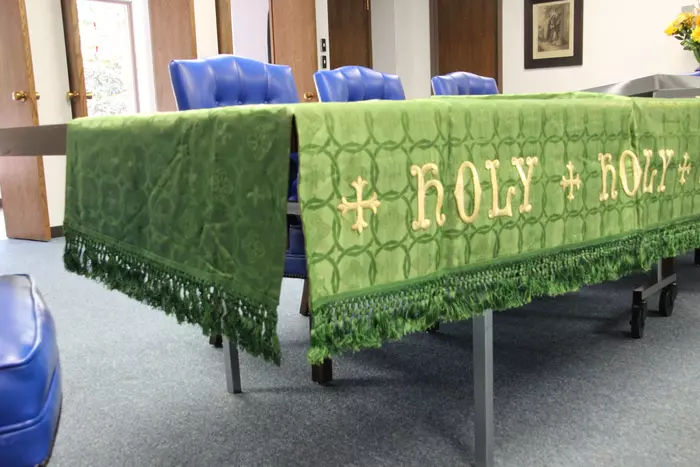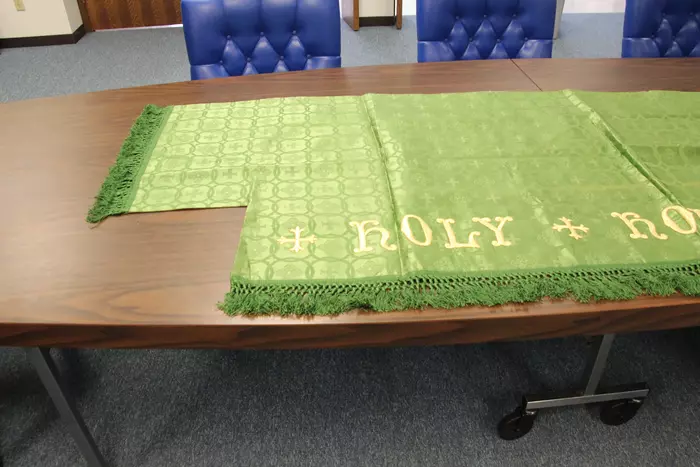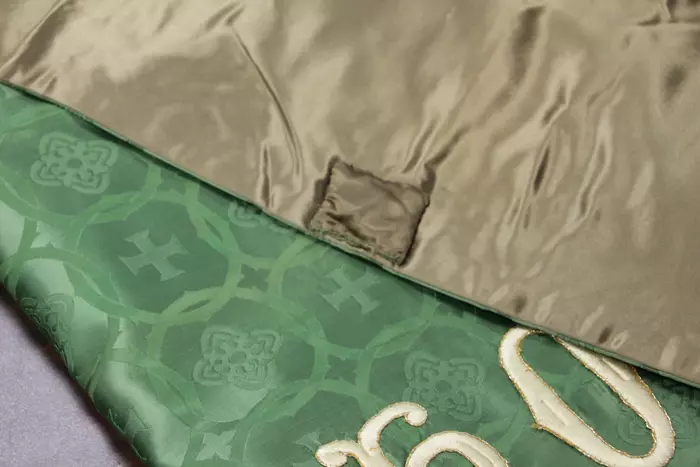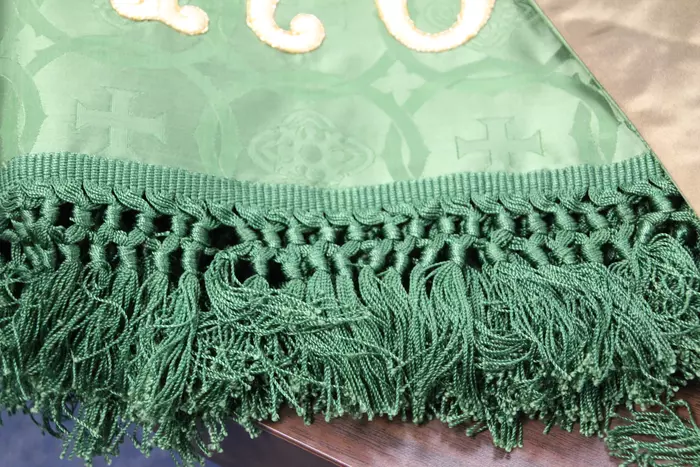Altar Frontals
Altar Frontals
I have been getting a few questions on the making of altar frontals over the past few weeks here on Ecclesiastical Sewing. I have some good news: written instructions are in the works. But it will take time to put those together, as I am traveling a great deal over the summer months. While the travel is fun, and much of the travel is related to Ecclesiastical Sewing, it disrupts work on current projects.

But traveling also presents a great opportunity for the study of Ecclesiastical Sewing and Ecclesiastical Embroidery. On my recent trip to St. Louis, Missouri, I planned several side trips to visit different locations and see their collection of Church Vestments and Church Altar Linens. For those interested in making altar frontals, the above Superfrontal photos might be helpful. The Superfrontal was part of the Church Parament Collection at the Concordia Historical Institute on the Campus of the Concordia Theological Seminary in St. Louis.

This retired altar superfrontal (Latin: Supra which means above – a piece of fabric above) is designed to fit the top of an altar while allowing for an overhang on the sides. The above photo shows the simple concept for the construction: a small square has been cut out from each corner and is used to create a space for the end to hang down on the side.
Fabric Solutions
The Ecclesiastical Fabric has been used as the base fabric for the entire Superfrontal. The Superfrontal is designed so that it extends to the back edge of the altar with no overhang down the back side. One could create this same style of superfrontal by using cotton duck or dowlas fabric for the decking (the part on top of the altar) and employing Ecclesiastical Brocade for the front and end pieces, thus reducing fabric cost.

There were several altar superfrontals of this style in the Concordia Historical Institute collection, and I noticed there was nothing visible to be used as a means of keeping the frontals in place. Usually, frontals have a rod pocket or some means of securing themselves in place. Then, noticing that several other vestment pieces in the box kept sticking together when they were moved, the method of keeping these superfrontals in place revealed itself: Heavy Magnets. This was something new and interesting to discover!
Magnets were placed in a small fabric square and sewn to the back edge of the superfrontal. It’s a clever idea and must have worked well.

Feature of Altar Superfrontal
The other interesting feature of this Altar Superfrontal is the fringe. Sadly this type of fringe is a challenge to come by today. Perhaps some of you might be aware of sources for this fringe, but most vestment houses do not have anything like this except for use on Bishops’ garments.
This vestment set is not a great work of Ecclesiastical art but it served a purpose. It was nicely made, was well used in its day, and can give an idea for a design style for Superfrontals.
Gathering these little bits of history makes for fun adventures when it is time for traveling and seeing Ecclesiastical Sewing Treasures.
Solo Dei Gloria
Be sure to visit our online store front Ecclesiastical Sewing where you may shop for Liturgical Fabrics, altar linen fabrics, church vestment-making patterns, liturgical machine embroidery designs, church vestment trims and notions and so much more. You may also find us on Ecclesiastical Sewing on Facebook, Twitter, and Pinterest. Sign up for our mailing list at the bottom of the page on our online store front and receive a free copy of our Small Linens Booklet as our way of saying thank you for following along.
Adding Fringe Trim to a Pulpit Fall or Superfrontal
Ecclesiastical Vestment Pattern Making
Frontal at St. Ignatius Mission
Church Vestment Fringe: is there a difference?
Frontal at St. Ignatius Mission






 RSS - Posts
RSS - Posts
I am about to try to make an altar frontal – do you ave any instructions please?
Thank you
Joy
England
Carrie – I remember seeing fringe of this type for use on drapes. I’ve seen it from time to time in upholstery fabric stores.
While they do have fringe in the fabric stores, and I have used it from time to time, the header on the fabric store fringe which is intended for upholstery is very heavy and thick. The header of Ecclesiastical fringe is much lighter, and much easier to baste in place if needed. It makes the job of adding fringe a little easier because one can ease it to the fabric, avoiding the issue of “take up” which causes puckers and bubbles. I remember the first time I saw the Ecclesiastical fringes and the nice light header. It was surprising. There is nothing that says the upholstery fringe can not be used, and I have used it in the past, but once one uses the Ecclesiastical fringe, it is hard to change back.